Leading Logistics Firms’ Re-Engineering through the Optimization of the Customer’s Social Media and Website Activity
Abstract
1. Introduction
1.1. Impact of Digitalization on Innovations and Customers’ Behavior
1.2. Digitalization and Change Management
1.3. Re-Engineering Marketing during Radical Business Transformation
1.4. Digitalization in Logistics: The Big Data Concept
1.5. Social/Web Analytics and Hypotheses Formulation
2. Materials and Methods
2.1. Statistical Analysis
2.2. Fuzzy Cognitive Map
3. Discussion
- H2 is accepted, which highlights that the bounce rate (visitors that exit the websites) has positive effects on social media visibility. This is an interesting result which highlights that users turn their focus more on social media than on logistics websites and further promotes better market segmentation, as indicated by previous research [116,117,118,119]. H3 is also accepted. This hypothesis, which is also supported by the FCM’s findings, suggests that the paid traffic in Google advertisements has negative effects on social media visibility. Therefore, logistics companies need to invest more in social media advertisements as advised from previous research in other industries [21,120].
- H4 is also accepted and supported by previous research. The results highlight that the digital brand name of corporate websites is highly affected by the website’s user activity [23,67]. However, it has no effect on the logistics app rating. This is an interesting outcome that has never been studied before, and therefore future research is welcomed.
- H5 is also accepted. This finding illustrates that social media interactivity has an imperceptible effect on the re-engineering strategy. Additionally, due to the high correlation between the paid traffic cost and the organic traffic cost, marketing managers are advised to equally reduce the amount of both social media ads and Google ads in order to produce an effective re-engineering process. This is an outcome that comes in contradiction with other industry digital entities, such as energy retail providers, and therefore logistics companies are highly suggested to use and create buyer personas so as to develop customized advertisements [121,122].
4. Conclusions
4.1. Theoretical Implications
4.2. Practical Implications
4.3. Global Implications and Market Forces
4.4. Limitations and Future Recommendations
Author Contributions
Funding
Institutional Review Board Statement
Informed Consent Statement
Data Availability Statement
Conflicts of Interest
References
- Büyüközkan, G.; Göçer, F. Digital Supply Chain: Literature Review and a Proposed Framework for Future Research. Comput. Ind. 2018, 97, 157–177. [Google Scholar] [CrossRef]
- Tran-Dang, H.; Krommenacker, N.; Charpentier, P.; Kim, D.-S. The Internet of Things for Logistics: Perspectives, Application Review, and Challenges. IETE Tech. Rev. 2022, 39, 93–121. [Google Scholar] [CrossRef]
- Yin, W.; Ran, W. Supply Chain Diversification, Digital Transformation, and Supply Chain Resilience: Configuration Analysis Based on fsQCA. Sustain. Sci. Pract. Policy 2022, 14, 7690. [Google Scholar] [CrossRef]
- Statista (2022). Spending on Digital Transformation Technologies and Services Worldwide from 2017 to 2026. Available online: https://www.statista.com/statistics/870924/worldwide-digital-transformation-market-size/ (accessed on 30 March 2023).
- García-Reyes, H.; Avilés-González, J.; Avilés-Sacoto, S.V. A Model to Become a Supply Chain 4.0 Based on a Digital Maturity Perspective. Procedia Comput. Sci. 2022, 200, 1058–1067. [Google Scholar] [CrossRef]
- Zouari, D.; Ruel, S.; Viale, L. Does Digitalising the Supply Chain Contribute to Its Resilience? Int. J. Phys. Distrib. Logist. Manag. 2020, 51, 149–180. [Google Scholar] [CrossRef]
- Parviainen, P.; Tihinen, M.; Kääriäinen, J.; Teppola, S. Tackling the Digitalization Challenge: How to Benefit from Digitalization in Practice. IJISPM 2017, 5, 63–77. [Google Scholar] [CrossRef]
- Bellantuono, N.; Nuzzi, A.; Pontrandolfo, P.; Scozzi, B. Digital Transformation Models for the I4.0 Transition: Lessons from the Change Management Literature. Sustain. Sci. Pract. Policy 2021, 13, 12941. [Google Scholar] [CrossRef]
- Song, Y.; Yu, F.R.; Zhou, L.; Yang, X.; He, Z. Applications of the Internet of Things (IoT) in Smart Logistics: A Comprehensive Survey. IEEE Internet Things J. 2021, 8, 4250–4274. [Google Scholar] [CrossRef]
- Chen, Y.-T.; Sun, E.W.; Chang, M.-F.; Lin, Y.-B. Pragmatic Real-Time Logistics Management with Traffic IoT Infrastructure: Big Data Predictive Analytics of Freight Travel Time for Logistics 4.0. Int. J. Prod. Econ. 2021, 238, 108157. [Google Scholar] [CrossRef]
- Glistau, E.; Coello Machado, N.I. Industry 4.0, Logistics 4.0 and Materials—Chances and Solutions. Mater. Sci. Forum 2018, 919, 307–314. [Google Scholar] [CrossRef]
- Irimiás, A.; Mitev, A. Change Management, Digital Maturity, and Green Development: Are Successful Firms Leveraging on Sustainability? Sustainability 2020, 12, 4019. [Google Scholar] [CrossRef]
- Saputra, D.A.; Handayani, P.W.; Satria, R. Customer Relationship Management (CRM) Implementation Evaluation Using Maturity Assessment in Telecommunication Industry: Case Study of an Indonesian Company. In Proceedings of the 2019 International Conference on Advanced Computer Science and information Systems (ICACSIS), Nusa Dua, Indonesia, 12–13 October 2019; pp. 513–518. [Google Scholar]
- Archibong, U.; Ibrahim, U.A. Assessing the Impact of Change Management on Employee Performance: Evidence from Nile University of Nigeria. IJRBS 2021, 10, 525–534. [Google Scholar] [CrossRef]
- Kumar, M. Knowledge Management: Process and Challenges. IOSR J. Bus. Manag. 2021, 23, 56–59. [Google Scholar]
- Freihat, S. The Role of Transformational Leadership in Reengineering of Marketing Strategies within Organizations. Probl. Perspect. Manag. 2020, 18, 364–375. [Google Scholar] [CrossRef]
- Baiyere, A.; Salmela, H.; Tapanainen, T. Digital Transformation and the New Logics of Business Process Management. Eur. J. Inf. Syst. 2020, 29, 238–259. [Google Scholar] [CrossRef]
- Hanelt, A.; Bohnsack, R.; Marz, D.; Antunes Marante, C. A Systematic Review of the Literature on Digital Transformation: Insights and Implications for Strategy and Organizational Change. J. Manag. Stud. 2021, 58, 1159–1197. [Google Scholar] [CrossRef]
- Vasilyeva, T.; Us, Y.; Lyulyov, A.; Pimonenko, T. Business process reengineering: From traditional to digital marketing. Vìsnik Sums’kogo Deržavnogo Unìversitetu 2020, 309–318. [Google Scholar] [CrossRef]
- Alsamydai, M.J. Marketing Engineering and Making Marketing Decisions. Int. J. Sci. Technol. Res. 2019, 8, 352–358. [Google Scholar]
- Chaikovska, M.; Shkeda, O. Reengineering Brand Communication with the Consumer by Integrating Pop Cultural Influencer Marketing Tools into Traditional Marketing Components. Mаркетинг I Цифрoві Технoлoгії 2021, 5, 63–71. [Google Scholar] [CrossRef]
- Zheng, P.; Chen, C.-H.; Shang, S. Towards an Automatic Engineering Change Management in Smart Product-Service Systems—A DSM-Based Learning Approach. Adv. Eng. Inform. 2019, 39, 203–213. [Google Scholar] [CrossRef]
- Giakomidou, D.S.; Kriemadis, A.; Nasiopoulos, D.K.; Mastrakoulis, D. Re-Engineering of Marketing for SMEs in Energy Market through Modeling Customers’ Strategic Behavior. Energies 2022, 15, 8179. [Google Scholar] [CrossRef]
- Sakas, D.P.; Reklitis, D.P.; Trivellas, P.; Vassilakis, C.; Terzi, M.C. The Effects of Logistics Websites’ Technical Factors on the Optimization of Digital Marketing Strategies and Corporate Brand Name. Processes 2022, 10, 892. [Google Scholar] [CrossRef]
- Nasiopoulos, D.Κ.; Sakas, D.P.; Trivellas, P. The Role of Digital Marketing in the Development of a Distribution and Logistics Network of Information Technology Companies. In Proceedings of the Business Intelligence and Modelling; Springer International Publishing: New York, NY, USA, 2021; pp. 267–276. [Google Scholar]
- Liu, C.; Feng, Y.; Lin, D.; Wu, L.; Guo, M. Iot Based Laundry Services: An Application of Big Data Analytics, Intelligent Logistics Management, and Machine Learning Techniques. Int. J. Prod. Res. 2020, 58, 5113–5131. [Google Scholar] [CrossRef]
- Agostini, L.; Galati, F.; Gastaldi, L. The Digitalization of the Innovation Process: Challenges and Opportunities from a Management Perspective. Eur. J. Innov. Manag. 2020, 23, 1–12. [Google Scholar] [CrossRef]
- Zaki, M. Digital Transformation: Harnessing Digital Technologies for the next Generation of Services. J. Prof. Serv. Mark. 2019, 33, 429–435. [Google Scholar] [CrossRef]
- Ciarli, T.; Kenney, M.; Massini, S.; Piscitello, L. Digital Technologies, Innovation, and Skills: Emerging Trajectories and Challenges. Res. Policy 2021, 50, 104289. [Google Scholar] [CrossRef]
- Hoyer, W.D.; Kroschke, M.; Schmitt, B.; Kraume, K.; Shankar, V. Transforming the Customer Experience through New Technologies. J. Interact. Mark. 2020, 51, 57–71. [Google Scholar] [CrossRef]
- Lee, S.M.; Lee, D. “Untact”: A New Customer Service Strategy in the Digital Age. Serv. Bus. 2020, 14, 1–22. [Google Scholar] [CrossRef]
- Keiningham, T.; Aksoy, L.; Bruce, H.L.; Cadet, F.; Clennell, N.; Hodgkinson, I.R.; Kearney, T. Customer Experience Driven Business Model Innovation. J. Bus. Res. 2020, 116, 431–440. [Google Scholar] [CrossRef]
- Srisathan, W.A.; Naruetharadhol, P. A COVID-19 Disruption: The Great Acceleration of Digitally Planned and Transformed Behaviors in Thailand. Technol. Soc. 2022, 68, 101912. [Google Scholar] [CrossRef]
- Oberoi, S.S. Modeling of the Shrinking Product Life Cycle. Theor. Econ. Lett. 2019, 9, 234–239. [Google Scholar] [CrossRef]
- Melander, L. Customer Involvement in Product Development: Using Voice of the Customer for Innovation and Marketing. Benchmarking Int. J. 2019, 27, 215–231. [Google Scholar] [CrossRef]
- Frishammar, J.; Richtnér, A.; Brattström, A.; Magnusson, M.; Björk, J. Opportunities and Challenges in the New Innovation Landscape: Implications for Innovation Auditing and Innovation Management. Eur. Manag. J. 2019, 37, 151–164. [Google Scholar] [CrossRef]
- Parveen, T.F.; Nadarajah, D.; Ismawati, J.N.; Sulaiman, A. The Impact of Digitalisation Vision and Information Technology on Organisations’ Innovation. Eur. J. Innov. Manag. 2021, 25, 607–629. [Google Scholar]
- Casalino, N.; Żuchowski, I.; Labrinos, N.; Munoz Nieto, Á.L.; Martín-Jiménez, J.A. Digital Strategies and Organizational Performances of SMEs in the Age of Coronavirus: Balancing Digital Transformation with An Effective Business Resilience. 2019. Available online: https://papers.ssrn.com (accessed on 21 May 2023).
- Al-Haddad, S.; Kotnour, T. Integrating the Organizational Change Literature: A Model for Successful Change. J. Organ. Chang Manag. 2015, 28, 234–262. [Google Scholar] [CrossRef]
- Sakas, D.P.; Reklitis, D.P.; Trivellas, P. European Logistics Firms’ digital Transformation through Social Media Analytics and Customer Reviews. In Proceedings of the Economic and Social Development: Book of Proceedings; Varazdin Development and Entrepreneurship: Varazdin, Croatia, 2023; pp. 88–95. [Google Scholar]
- Sadeghi, J.K.; Struckell, E.; Ojha, D.; Nowicki, D. Absorptive Capacity and Disaster Immunity: The Mediating Role of Information Quality and Change Management Capability. J. Knowl. Manag. 2020, 25, 714–742. [Google Scholar] [CrossRef]
- Phillips, J.; Klein, J.D. Change Management: From Theory to Practice. TechTrends 2023, 67, 189–197. [Google Scholar] [CrossRef] [PubMed]
- Van Hoek, R. Responding to COVID-19 Supply Chain Risks—Insights from Supply Chain Change Management, Total Cost of Ownership and Supplier Segmentation Theory. Logistics 2020, 4, 23. [Google Scholar] [CrossRef]
- Alshurideh, M.; Al Kurdi, B.H.; Alzoubi, H.M.; Salloum, S. The Effect of Information Technology on Business and Marketing Intelligence Systems; Springer Nature: New York, NY, USA, 2023; ISBN 9783031123825. [Google Scholar]
- Asamoah, D.; Nuertey, D.; Agyei-Owusu, B.; Akyeh, J. The Effect of Supply Chain Responsiveness on Customer Development. Int. J. Logist. Manag. 2021, 32, 1190–1213. [Google Scholar] [CrossRef]
- Thordsen, T.; Bick, M. Towards a Holistic Digital Maturity Model. In Proceedings of the ICIS 2020 Proceedings; Association for Computing Machinery: New York, NY, USA, 2020. Available online: https://web.archive.org/web/20220803135014id_/https://aisel.aisnet.org/cgi/viewcontent.cgi?article=1208&context=icis2020 (accessed on 1 April 2023).
- Yeh, T.-M.; Chen, S.-H.; Chen, T.-F. The Relationships among Experiential Marketing, Service Innovation, and Customer Satisfaction—A Case Study of Tourism Factories in Taiwan. Sustain. Sci. Pract. Policy 2019, 11, 1041. [Google Scholar] [CrossRef]
- Liu, Y.; Soroka, A.; Han, L.; Jian, J.; Tang, M. Cloud-Based Big Data Analytics for Customer Insight-Driven Design Innovation in SMEs. Int. J. Inf. Manag. 2020, 51, 102034. [Google Scholar] [CrossRef]
- Steward, M.D.; Narus, J.A.; Roehm, M.L.; Ritz, W. From Transactions to Journeys and beyond: The Evolution of B2B Buying Process Modeling. Ind. Mark. Manag. 2019, 83, 288–300. [Google Scholar] [CrossRef]
- Holmlund, M.; Van Vaerenbergh, Y.; Ciuchita, R.; Ravald, A.; Sarantopoulos, P.; Ordenes, F.V.; Zaki, M. Customer Experience Management in the Age of Big Data Analytics: A Strategic Framework. J. Bus. Res. 2020, 116, 356–365. [Google Scholar] [CrossRef]
- Terho, H.; Mero, J.; Siutla, L.; Jaakkola, E. Digital Content Marketing in Business Markets: Activities, Consequences, and Contingencies along the Customer Journey. Ind. Mark. Manag. 2022, 105, 294–310. [Google Scholar] [CrossRef]
- Bushuyev, S.; Bushuieva, V.; Bushuyeva, N.; Bushuiev, D. Conceptual Model of Project Digital Footprint. In Proceedings of the 2021 IEEE 16th International Conference on Computer Sciences and Information Technologies (CSIT), Lviv, Ukraine, 22–25 September 2021; Volume 2, pp. 327–332. [Google Scholar]
- Miklosik, A.; Evans, N. Impact of Big Data and Machine Learning on Digital Transformation in Marketing: A Literature Review. IEEE Access 2020, 8, 101284–101292. [Google Scholar] [CrossRef]
- Taraniuk, L.; Kobyzskyi, D.S.; Thomson, M. Estimation of the marketing potential of industrial enterprises in the period of re-engineering of business processes. Probl. Perspect. Manag. 2018, 16, 412–423. [Google Scholar] [CrossRef]
- Shukla, V.; Miri, R. Analysis of User Behavior in Social Media Using Business Process Re- Engineering and Learning Technique. Available online: https://www.webology.org/data-cms/articles/20220716045515pmwebology%2018%20(6)%20-%20533.pdf (accessed on 26 May 2023).
- Melnyk, L.H.; Derykolenko, O.M.; Matsenko, O.M.; Pasyevin, O.O.; Khymchenko, Y.V. Organizational and Economic Potential of Joint Engagement of Venture Capital and Business Process Re-Engineering in the Marketing Activities of Industrial Enterprises. Mech. Econ. Regul. 2019, 17–29. [Google Scholar] [CrossRef]
- Romanovskaya, E.V.; Garina, E.P.; Andryashina, N.S.; Kuznetsova, S.N.; Artemyeva, M.V. Studying the Experience of Reengineering Business Processes in the Practice of Domestic Enterprises: Problems and Prospects of Application. In Growth Poles of the Global Economy: Emergence, Changes and Future Perspectives; Popkova, E.G., Ed.; Springer International Publishing: Cham, Switzerland, 2020; pp. 517–524. ISBN 9783030151607. [Google Scholar]
- Venkateswaran, J. Establishing a Strong Digital Foundation for a 150-Year-Old Building Society with Business Process Re-Engineering and RPA. J. Digit. Bank. 2022, 7, 129–141. [Google Scholar]
- Shahira, S.H.N.; Salamzadeh, Y.; Fareen, A.R.N.; Salamzadeh, A. The Impact of Business Process Reengineering on Organizational Performance during the Coronavirus Pandemic: Moderating Role of Strategic Thinking. Foresight 2021, 24, 637–655. [Google Scholar]
- Wedel, M.; Kannan, P.K. Marketing Analytics for Data-Rich Environments. J. Mark. 2016, 80, 97–121. [Google Scholar] [CrossRef]
- Jha, M.; Jha, S.; O’Brien, L. Combining Big Data Analytics with Business Process Using Reengineering. In Proceedings of the 2016 IEEE Tenth International, Laguna Hills, CA, USA, 1–3 June 2016. [Google Scholar]
- Pandey, N.; Nayal, P.; Singh, R.A. Digital Marketing for B2B Organizations: Structured Literature Review and Future Research Directions. J. Bus. Ind. Mark. 2020, 35, 1191–1204. [Google Scholar] [CrossRef]
- Gour, A.; Aggarwal, S.; Erdem, M. Reading between the Lines: Analyzing Online Reviews by Using a Multi-Method Web-Analytics Approach. Int. J. Contemp. Hosp. Manag. 2021, 33, 490–512. [Google Scholar] [CrossRef]
- Ponzoa, J.M.; Erdmann, A. E-Commerce Customer Attraction: Digital Marketing Techniques, Evolution and Dynamics across Firms. J. Promot. Manag. 2021, 27, 697–715. [Google Scholar] [CrossRef]
- Sakas, D.P.; Kamperos, I.D.G.; Terzi, M.C. The Long-Term Risk Familiarity Effect on Courier Services’ Digital Branding during the COVID-19 Crisis. J. Theor. Appl. Electron. Commer. Res. 2022, 17, 1655–1684. [Google Scholar] [CrossRef]
- Sakas, D.P.; Reklitis, D.P.; Terzi, M.C.; Vassilakis, C. Multichannel Digital Marketing Optimizations through Big Data Analytics in the Tourism and Hospitality Industry. J. Theor. Appl. Electron. Commer. Res. 2022, 17, 1383–1408. [Google Scholar] [CrossRef]
- Reklitis, P.; Trivellas, P.; Mantzaris, I.; Mantzari, E.; Reklitis, D. Employee Perceptions of Corporate Social Responsibility Activities and Work-Related Attitudes: The Case of a Greek Management Services Organization. In Sustainability and Social Responsibility; Springer: Singapore, 2018. [Google Scholar]
- Sakas, D.P.; Giannakopoulos, N.T.; Terzi, M.C.; Kamperos, I.D.; Nasiopoulos, D.K.; Reklitis, D.P.; Kanellos, N. Social media strategy processes for centralized payment network firms after a war crisis outset. Processes 2022, 10, 1995. [Google Scholar] [CrossRef]
- Sakas, D.P.; Reklitis, D.P. Predictive Model for Estimating the Impact of Technical Issues on Consumers Interaction in Agri-Logistics Websites. In Technologies for Agriculture—Theme IV: Actions; Springer International Publishing: Cham, Switzerland, 2022. [Google Scholar]
- Sakas, D.P.; Reklitis, D.P. The Impact of Organic Traffic of Crowdsourcing Platforms on Airlines’ Website Traffic and User Engagement. Sustainability 2021, 13, 8850. [Google Scholar] [CrossRef]
- Tavana, M.; Shaabani, A.; Raeesi Vanani, I.; Kumar Gangadhari, R. A Review of Digital Transformation on Supply Chain Process Management Using Text Mining. Processes 2022, 10, 842. [Google Scholar] [CrossRef]
- Sandberg, E.; Hemilä, J. Digitalization in Industrial Logistics and Supply Chains: The Contemporary Situation in Sweden and Finland. In Proceedings of the 23rd International Symposium on Logistics, ISL, Bali, Indonesia, 8–11 July 2018. [Google Scholar]
- Preindl, R.; Nikolopoulos, K.; Litsiou, K. Transformation Strategies for the Supply Chain: The Impact of Industry 4.0 and Digital Transformation. Supply Chain. Forum Int. J. 2020, 21, 26–34. [Google Scholar] [CrossRef]
- Transparency Market Research (2018). Digital Transformation Spending in Logistics Market. Available online: https://www.transparencymarketresearch.com/digital-transformation-spending-logistics-market.html (accessed on 30 March 2023).
- Mashalah, H.A.; Hassini, E.; Gunasekaran, A.; Bhatt (Mishra), D. The Impact of Digital Transformation on Supply Chains through E-Commerce: Literature Review and a Conceptual Framework. Transp. Res. Part E Logist. Trans. Rev. 2022, 165, 102837. [Google Scholar] [CrossRef]
- Statista (2023). Number of Internet and Social Media Users Worldwide as of January 2023. Available online: https://www.statista.com/statistics/617136/digital-population-worldwide/ (accessed on 30 March 2023).
- Zondervan, N.A.; Tolentino-Zondervan, F.; Moeke, D. Logistics Trends and Innovations in Response to COVID-19 Pandemic: An Analysis Using Text Mining. Processes 2022, 10, 2667. [Google Scholar] [CrossRef]
- Wang, G.; Gunasekaran, A.; Ngai, E.W.T.; Papadopoulos, T. Big Data Analytics in Logistics and Supply Chain Management: Certain Investigations for Research and Applications. Int. J. Prod. Econ. 2016, 176, 98–110. [Google Scholar] [CrossRef]
- Kong, X.T.R.; Zhong, R.Y.; Zhao, Z.; Shao, S.; Li, M.; Lin, P.; Chen, Y.; Wu, W.; Shen, L.; Yu, Y.; et al. Cyber Physical Ecommerce Logistics System: An Implementation Case in Hong Kong. Comput. Ind. Eng. 2020, 139, 106170. [Google Scholar] [CrossRef]
- Winkelhaus, S.; Grosse, E.H. Logistics 4.0: A Systematic Review towards a New Logistics System. Int. J. Prod. Res. 2020, 58, 18–43. [Google Scholar] [CrossRef]
- Maheshwari, S.; Gautam, P.; Jaggi, C.K. Role of Big Data Analytics in Supply Chain Management: Current Trends and Future Perspectives. Int. J. Prod. Res. 2021, 59, 1875–1900. [Google Scholar] [CrossRef]
- Gunasekaran, A.; Papadopoulos, T.; Dubey, R.; Wamba, S.F.; Childe, S.J.; Hazen, B.; Akter, S. Big Data and Predictive Analytics for Supply Chain and Organizational Performance. J. Bus. Res. 2017, 70, 308–317. [Google Scholar] [CrossRef]
- Yang, D.; Wu, L.; Wang, S.; Jia, H.; Li, K.X. How Big Data Enriches Maritime Research—A Critical Review of Automatic Identification System (AIS) Data Applications. Transp. Rev. 2019, 39, 755–773. [Google Scholar] [CrossRef]
- Chen, S.-H.; Venkatachalam, R. Agent-Based Modelling as a Foundation for Big Data. J. Econ. Methodol. 2017, 24, 362–383. [Google Scholar] [CrossRef]
- Kodym, O.; Kubáč, L.; Kavka, L. Risks Associated with Logistics 4.0 and Their Minimization Using Blockchain. Open Eng. 2020, 10, 74–85. [Google Scholar] [CrossRef]
- Dai, H.-N.; Wang, H.; Xu, G.; Wan, J.; Imran, M. Big Data Analytics for Manufacturing Internet of Things: Opportunities, Challenges and Enabling Technologies. Enterp. Inf. Syst. 2020, 14, 1279–1303. [Google Scholar] [CrossRef]
- Bag, S.; Gupta, S.; Luo, Z. Examining the Role of Logistics 4.0 Enabled Dynamic Capabilities on Firm Performance. Int. J. Logist. Manag. 2020, 31, 607–628. [Google Scholar] [CrossRef]
- Li, L.; Gong, Y.; Wang, Z.; Liu, S. Big Data and Big Disaster: A Mechanism of Supply Chain Risk Management in Global Logistics Industry. Int. J. Oper. Prod. Manag. 2022, 43, 274–307. [Google Scholar] [CrossRef]
- Peter, M.K.; Dalla Vecchia, M. The Digital Marketing Toolkit: A Literature Review for the Identification of Digital Marketing Channels and Platforms. In New Trends in Business Information Systems and Technology: Digital Innovation and Digital Business Transformation; Dornberger, R., Ed.; Springer International Publishing: Cham, Switzerland, 2021; pp. 251–265. ISBN 9783030483326. [Google Scholar]
- Susanto, H.; Sari, A.; Leu, F.-Y. Innovative Business Process Reengineering Adoption: Framework of Big Data Sentiment, Improving Customers’ Service Level Agreement. Big Data Cogn. Comput. 2022, 6, 151. [Google Scholar] [CrossRef]
- Dubolazov, V.; Tayushev, S.; Gabdrakhmanova, I.; Simakova, Z.; Leicht, O. Re-Engineering of Logistics Business Processes Influenced by the Digitalization. In Proceedings of the XIV International Scientific Conference “INTERAGROMASH 2021”, Rostov-on-Don, Russia, 24–26 February 2021; Springer International Publishing: New York, NY, USA, 2022; pp. 539–547. [Google Scholar]
- Ge, J.; Wang, F.; Sun, H.; Fu, L.; Sun, M. Research on the Maturity of Big Data Management Capability of Intelligent Manufacturing Enterprise. Syst. Res. Behav. Sci. 2020, 37, 646–662. [Google Scholar] [CrossRef]
- Nasiopoulos, D.K.; Mastrakoulis, D.M.; Arvanitidis, D.A. The Contribution of Digital Technology to the Forecasting of Supply Chain Development, in IT Products, Modeling and Simulation of the Problem. Forecasting 2022, 4, 1019–1037. [Google Scholar] [CrossRef]
- Marshall, D.A.; Burgos-Liz, L.; Pasupathy, K.S.; Padula, W.V.; IJzerman, M.J.; Wong, P.K.; Higashi, M.K.; Engbers, J.; Wiebe, S.; Crown, W.; et al. Transforming Healthcare Delivery: Integrating Dynamic Simulation Modelling and Big Data in Health Economics and Outcomes Research. Pharmacoeconomics 2016, 34, 115–126. [Google Scholar] [CrossRef] [PubMed]
- Misirlis, N.; Vlachopoulou, M. Social Media Metrics and Analytics in Marketing—S3M: A Mapping Literature Review. Int. J. Inf. Manag. 2018, 38, 270–276. [Google Scholar] [CrossRef]
- Saura, J.R.; Palos-Sánchez, P.; Cerdá Suárez, L.M. Understanding the Digital Marketing Environment with KPIs and Web Analytics. Future Internet 2017, 9, 76. [Google Scholar] [CrossRef]
- Drivas, I.C.; Kouis, D.; Kyriaki-Manessi, D. Social Media Analytics and Metrics for Improving Users Engagement. Knowledge 2022, 2, 225–242. [Google Scholar] [CrossRef]
- Kaplan, A.M.; Haenlein, M. Users of the World, Unite! The Challenges and Opportunities of Social Media. Bus. Horiz. 2010, 53, 59–68. [Google Scholar] [CrossRef]
- Semrush. Traffic Analytics Overview Report Manual. Available online: https://www.semrush.com/kb/895-trafficanalyticsoverview-report (accessed on 9 April 2023).
- Academy.fanpagekarma. Available online: https://academy.fanpagekarma.com (accessed on 9 April 2023).
- Picoto, W.N.; Duarte, R.; Pinto, I. Uncovering Top-Ranking Factors for Mobile Apps through a Multimethod Approach. J. Bus. Res. 2019, 101, 668–674. [Google Scholar] [CrossRef]
- Byun, D.-H.; Yang, H.-N.; Chung, D.-S. Evaluation of Mobile Applications Usability of Logistics in Life Startups. Sustain. Sci. Pract. Policy 2020, 12, 9023. [Google Scholar] [CrossRef]
- Leung, D.; Law, R.; van Hoof, H.; Buhalis, D. Social Media in Tourism and Hospitality: A Literature Review. J. Travel Tour. Mark. 2013, 30, 3–22. [Google Scholar] [CrossRef]
- Kim, A.J.; Ko, E. Impacts of Luxury Fashion Brand’s Social Media Marketing on Customer Relationship and Purchase Intention. J. Glob. Fash. Mark. 2010, 1, 164–171. [Google Scholar] [CrossRef]
- Morais, E.P.; Cunha, C.R.; Santos, A. Understanding the Value of Digital Marketing Tools for SMEs. In Proceedings of the Marketing and Smart Technologies; Springer: Singapore, 2021; pp. 769–779. [Google Scholar]
- Cunha, C.R.; Carvalho, A.; Esteves, E. Reengineering the Way Tourists Interact with Heritage: A Conceptual IoT Based Model. In Proceedings of the 4th International Conference on Tourism Research ICTR 2021, Porto, Portugal, 20–21 May 2021; pp. 166–173. [Google Scholar]
- Armstrong & Associates, Inc. A&A’s Top 50 Global Third-Party Logistics Providers (3PLs) List Largest 3PLs Ranked by 2021 Gross Logistics Revenue/Turnover. Available online: https://www.3plogistics.com/3pl-market-info-resources/3pl-market-information/aas-top-50-global-third-party-logistics-providers-3pls-list/ (accessed on 10 April 2023).
- Top 100 3PL Providers. Available online: https://www.inboundlogistics.com/top-100-3pls/ (accessed on 10 April 2023).
- Giabbanelli, P.J.; Gray, S.A.; Aminpour, P. Combining Fuzzy Cognitive Maps with Agent-Based Modeling: Frameworks and Pitfalls of a Powerful Hybrid Modeling Approach to Understand Human-Environment Interactions. Environ. Model. Softw. 2017, 95, 320–325. [Google Scholar] [CrossRef]
- Son, C.; Kim, J.; Kim, Y. Developing Scenario-Based Technology Roadmap in the Big Data Era: An Utilisation of Fuzzy Cognitive Map and Text Mining Techniques. Technol. Anal. Strateg. Manag. 2020, 32, 272–291. [Google Scholar] [CrossRef]
- Kokkinos, K.; Lakioti, E.; Papageorgiou, E.; Moustakas, K.; Karayannis, V. Fuzzy Cognitive Map-Based Modeling of Social Acceptance to Overcome Uncertainties in Establishing Waste Biorefinery Facilities. Front. Energy Res. 2018, 6, 112. [Google Scholar] [CrossRef]
- Nuanmeesri, S. Mobile Application for the Purpose of Marketing, Product Distribution and Location-Based Logistics for Elderly Farmers. Appl. Comput. Inform. 2023, 19, 2–21. [Google Scholar] [CrossRef]
- Tadejko, P. Application of Internet of Things in Logistics -Current Challenges. Ekon. I Zarządzanie 2015, 7, 54–64. [Google Scholar]
- Dela Cruz, D.R.; Mendoza, D.M.M. Milktrack: Design and Development of Mobile Application and Logistics System in Empowering Breastfeeding Practice in the Philippines. In Proceedings of the TENCON 2017—2017 IEEE Region 10 Conference, Penang, Malaysia, 5–8 November 2017; pp. 2242–2246. [Google Scholar]
- Simkin, L.; Dibb, S. Social Media’s Impact on Market Segmentation and CRM. J. Strateg. Mark. 2013, 21, 391–393. [Google Scholar] [CrossRef]
- Pridmore, J.; Hämäläinen, L.E. Market Segmentation in (in)action: Marketing and “yet to Be Installed” Role of Big and Social Media Data. Hist. Soc. Res. 2017, 42, 103–122. [Google Scholar]
- Constantinides, E.; Zinck Stagno, M.C. Potential of the Social Media as Instruments of Higher Education Marketing: A Segmentation Study. J. Mark. High. Educ. 2011, 21, 7–24. [Google Scholar] [CrossRef]
- Vinerean, S.; Cetina, I.; Dumitrescu, L.; Tichindelean, M. The Effects of Social Media Marketing on Online Consumer Behavior. Int. J. Indian Cult. Bus. Manag. 2013, 8, 66. [Google Scholar] [CrossRef]
- Hanaysha, J. The Importance of Social Media Advertisements in Enhancing Brand Equity: A Study on Fast Food Restaurant Industry in Malaysia. Int. J. Innov. Technol. Manag. 2016, 7, 46–51. [Google Scholar] [CrossRef]
- Misra, A.K.; Rai, R.K.; Takeuchi, Y. Modeling the Control of Infectious Diseases: Effects of TV and Social Media Advertisements. Math. Biosci. Eng. 2018, 15, 1315–1343. [Google Scholar] [CrossRef]
- Akre, V.; Rajan, A.; Ahamed, J.; Al Amri, A.; Al Daisi, S. Smart Digital Marketing of Financial Services to Millennial Generation Using Emerging Technological Tools and Buyer Persona. In Proceedings of the 2019 Sixth HCT Information Technology Trends (ITT), Ras Al Khaimah, UAE, 20–21 November 2019; pp. 120–125. [Google Scholar]
- Cruz, A.; Karatzas, S. Understanding Your Buyer Persona. In Digital and Social Media Marketing; Routledge: Milton Park, UK, 2020. [Google Scholar]
- Terragni, A.; Hassani, M. Optimizing Customer Journey Using Process Mining and Sequence-Aware Recommendation. In Proceedings of the 34th ACM/SIGAPP Symposium on Applied Computing; Association for Computing Machinery: New York, NY, USA, 2019; pp. 57–65. [Google Scholar]
- Cichosz, M.; Marcus, W.C.; Knemeyer, A.M. Digital Transformation at Logistics Service Providers: Barriers, Success Factors and Leading Practices. Int. J. Logist. Manag. 2020, 31, 209–238. [Google Scholar] [CrossRef]
- Krauss, J.; Vanhove, A.J. Organizational Culture Perceptions and Change Frequency: The Moderating Effect of Members’ Hierarchical Level in the Organization. Leadersh. Organ. Dev. J. 2022, 43, 302–314. [Google Scholar] [CrossRef]
- Sivarajah, U.; Irani, Z.; Gupta, S.; Mahroof, K. Role of Big Data and Social Media Analytics for Business to Business Sustainability: A Participatory Web Context. Ind. Mark. Manag. 2020, 86, 163–179. [Google Scholar] [CrossRef]
- Serbetcioglu, C.; Göçer, A. Examining Social Media Branding Profiles of Logistics Service Providers. J. Bus. Ind. Mark. 2020, 35, 2023–2038. [Google Scholar] [CrossRef]
- Suoniemi, S.; Meyer-Waarden, L.; Munzel, A.; Zablah, A.R.; Straub, D. Big Data and Firm Performance: The Roles of Market-Directed Capabilities and Business Strategy. Inf. Manag. 2020, 57, 103365. [Google Scholar] [CrossRef]
- Sestino, A.; Prete, M.I.; Piper, L.; Guido, G. Internet of Things and Big Data as Enablers for Business Digitalization Strategies. Technovation 2020, 98, 102173. [Google Scholar] [CrossRef]
- Johnson, D.S.; Muzellec, L.; Sihi, D.; Zahay, D. The Marketing Organization’s Journey to Become Data-Driven. J. Res. Interact. Mark. 2019, 13, 162–178. [Google Scholar] [CrossRef]
- Vollrath, M.D.; Villegas, S.G. Avoiding Digital Marketing Analytics Myopia: Revisiting the Customer Decision Journey as a Strategic Marketing Framework. J. Mark. Anal. 2022, 10, 106–113. [Google Scholar] [CrossRef]
- Roumeliotis, K.I.; Tselikas, N.D.; Nasiopoulos, D.K. Airlines’ Sustainability Study Based on Search Engine Optimization Techniques and Technologies. Sustainability 2022, 14, 11225. [Google Scholar] [CrossRef]
- Qalati, S.A.; Yuan, L.W.; Khan, M.A.S.; Anwar, F. A Mediated Model on the Adoption of Social Media and SMEs’ Performance in Developing Countries. Technol. Soc. 2021, 64, 101513. [Google Scholar] [CrossRef]
- Arriagada, A.; Ibáñez, F. “You Need At Least One Picture Daily, If Not, You’re Dead”: Content Creators and Platform Evolution in the Social Media Ecology. Soc. Media Soc. 2020, 6, 2056305120944624. [Google Scholar] [CrossRef]
- Choi, J.; Yoon, J.; Chung, J.; Coh, B.-Y.; Lee, J.-M. Social Media Analytics and Business Intelligence Research: A Systematic Review. Inf. Process. Manag. 2020, 57, 102279. [Google Scholar] [CrossRef]
- Espinosa, J.A.; Armour, F. The Big Data Analytics Gold Rush: A Research Framework for Coordination and Governance. In Proceedings of the 2016 49th Hawaii International Conference on System Sciences (HICSS), Koloa, HI, USA, 5–8 January 2016; pp. 1112–1121. [Google Scholar]
- Radivojević, G.; Milosavljević, L. The concept of logistics 4.0. In Proceedings of the 4th Logistics International Conference, Belgrade, Serbia, 23–25 May 2019; pp. 23–25. Available online: https://logic.sf.bg.ac.rs/wp-content/uploads/LOGIC_2019_ID_32.pdf (accessed on 31 March 2023).
- Schweidel, D.A.; Bart, Y.; Inman, J.J.; Stephen, A.T.; Libai, B.; Andrews, M.; Rosario, A.B.; Chae, I.; Chen, Z.; Kupor, D.; et al. How Consumer Digital Signals Are Reshaping the Customer Journey. J. Acad. Mark. Sci. 2022, 50, 1257–1276. [Google Scholar] [CrossRef] [PubMed]
- König, C.; Caldwell, N.D.; Ghadge, A. Service Provider Boundaries in Competitive Markets: The Case of the Logistics Industry. Int. J. Prod. Res. 2019, 57, 5624–5639. [Google Scholar] [CrossRef]
- Khan, S.A.R.; Zhang, Y.; Kumar, A.; Zavadskas, E.; Streimikiene, D. Measuring the Impact of Renewable Energy, Public Health Expenditure, Logistics, and Environmental Performance on Sustainable Economic Growth. Sustain. Dev. 2020, 28, 833–843. [Google Scholar] [CrossRef]
- Wang, C.; Kim, Y.-S.; Kim, C.Y. Causality between Logistics Infrastructure and Economic Development in China. Transp. Policy 2021, 100, 49–58. [Google Scholar] [CrossRef]
- Fayez, A.O.; Mahjoub, D.M.; Najaf, K.; Francisco, F.G. Impact of COVID-19 on Financial Performance of Logistics Firms: Evidence from G-20 Countries. J. Glob. Oper. Strateg. Sourc. 2021, 15, 172–196. [Google Scholar]
- Pwc.com. Shifting Patterns: The Future of the Logistics Industry. Available online: https://www.pwc.com/sg/en/publications/assets/future-of-the-logistics-industry.pdf (accessed on 25 May 2023).
- Sheng, J.; Amankwah-Amoah, J.; Khan, Z.; Wang, X. COVID-19 Pandemic in the New Era of Big Data Analytics: Methodological Innovations and Future Research Directions. Br. J. Manag. 2021, 32, 1164–1183. [Google Scholar] [CrossRef]
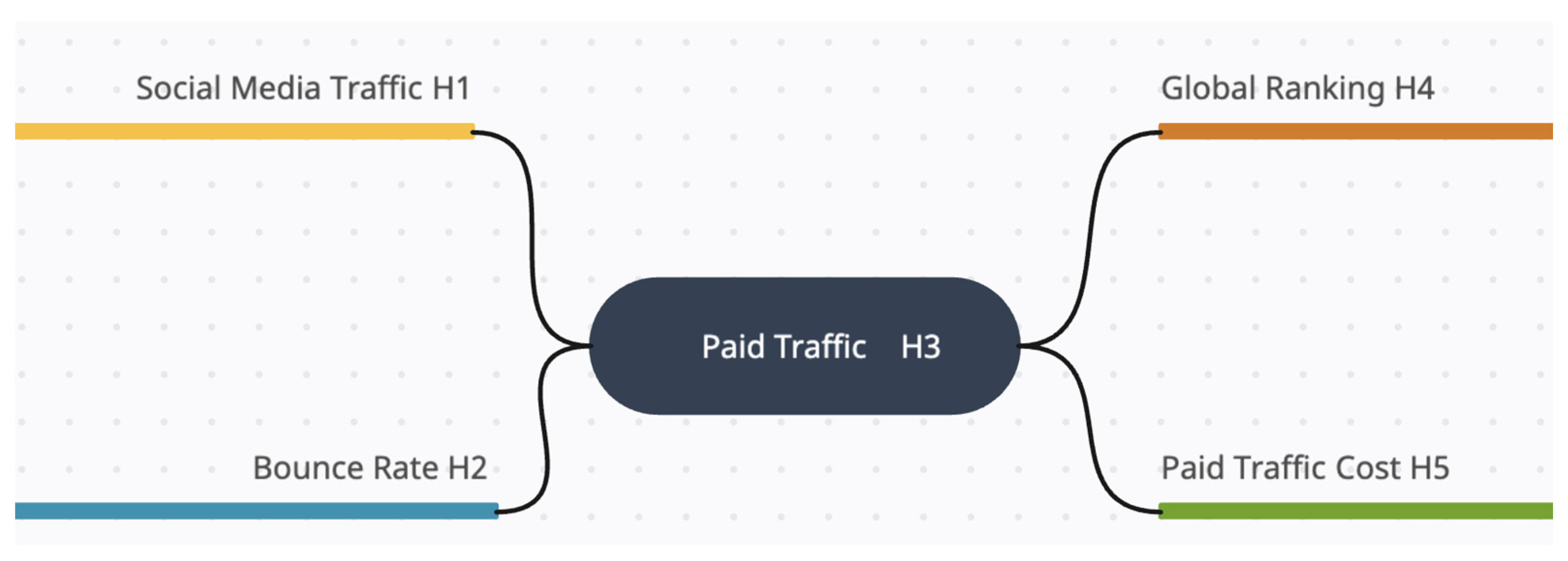
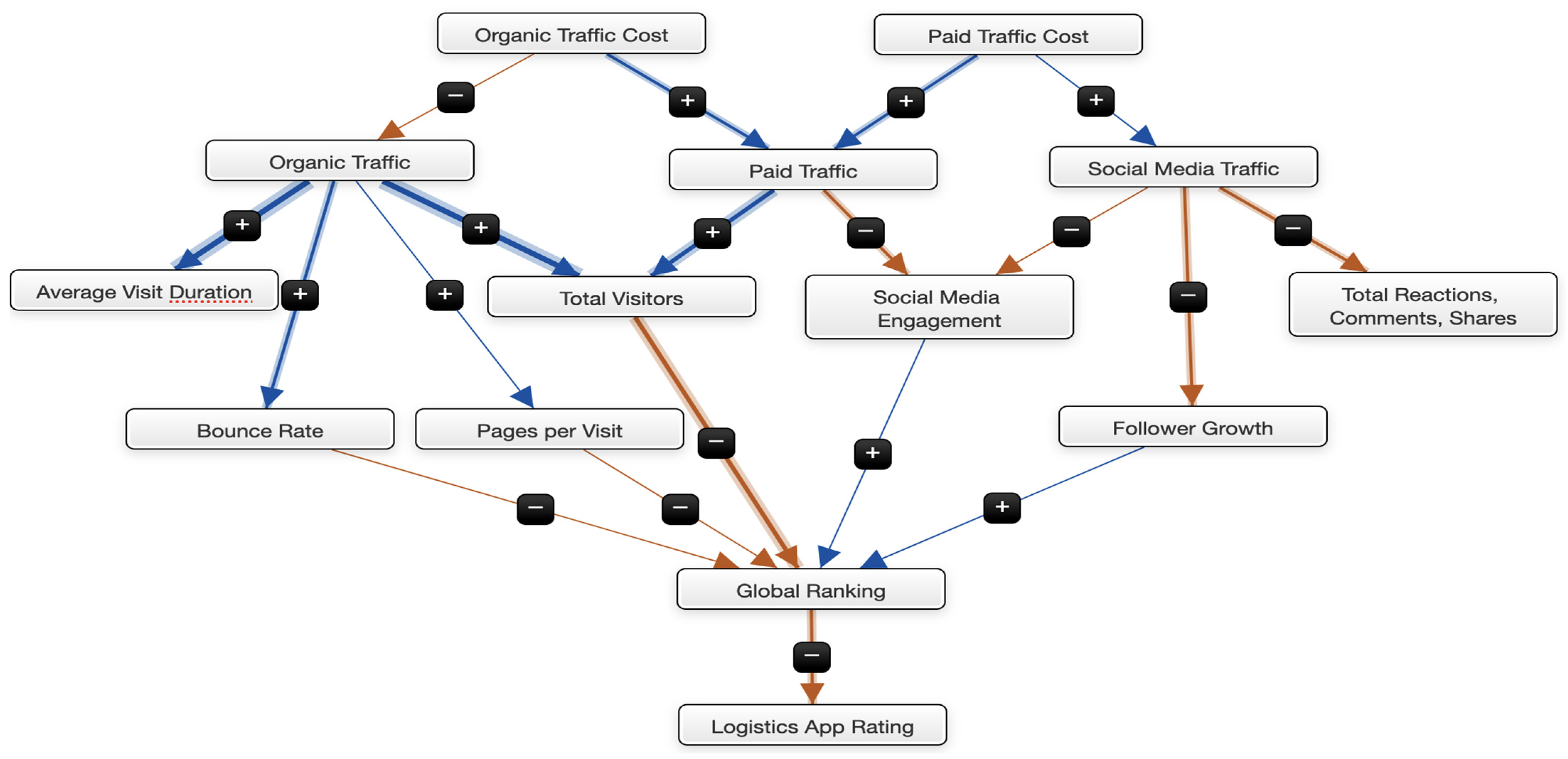
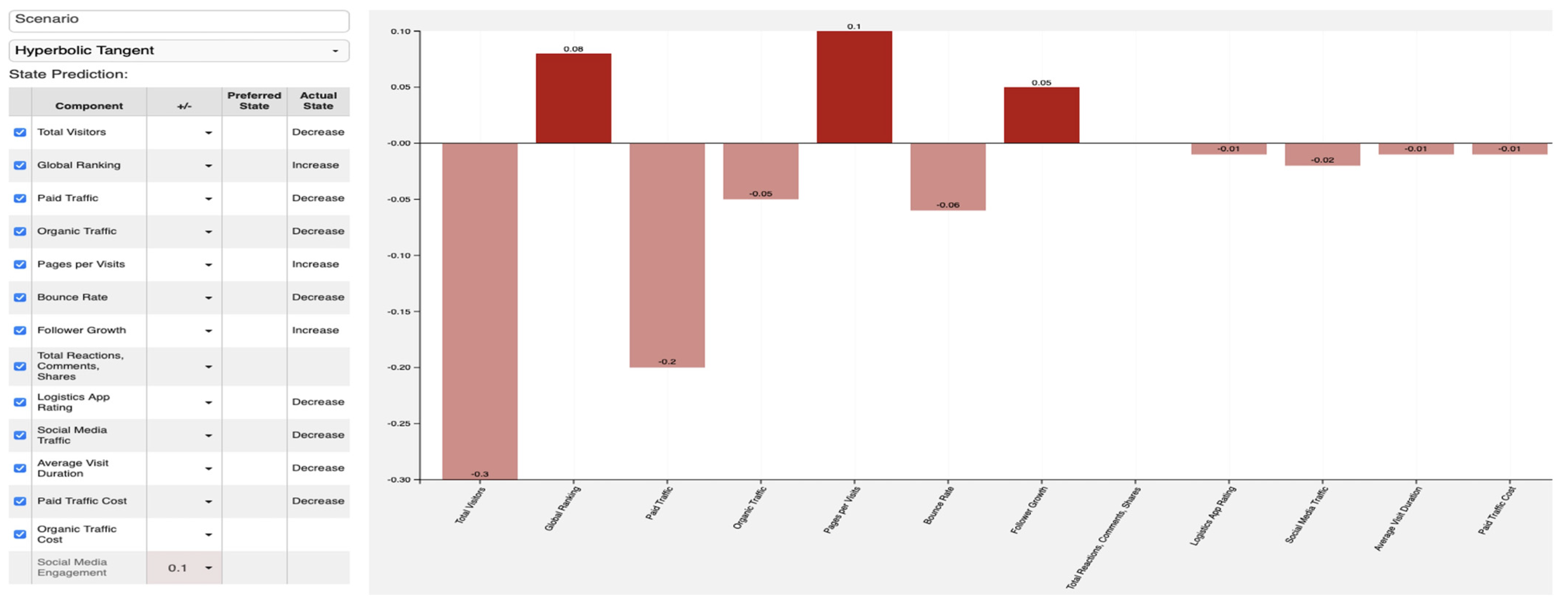
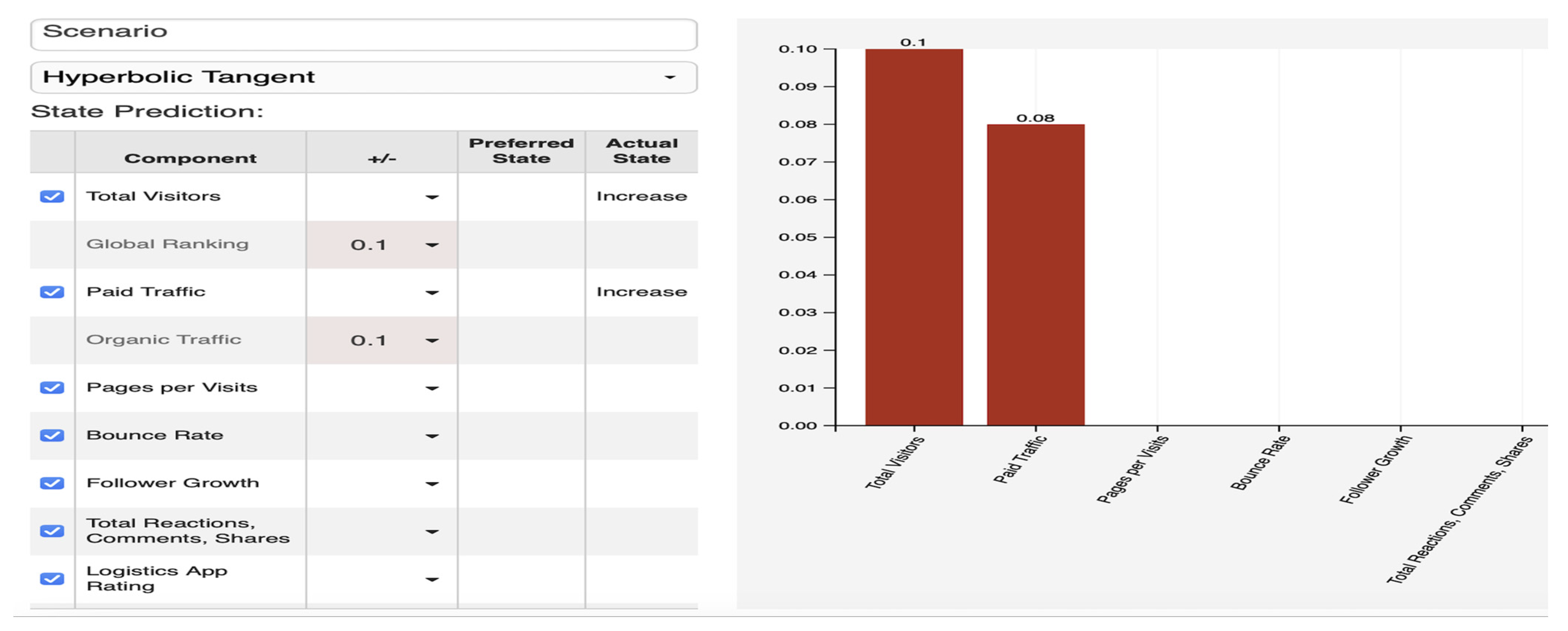
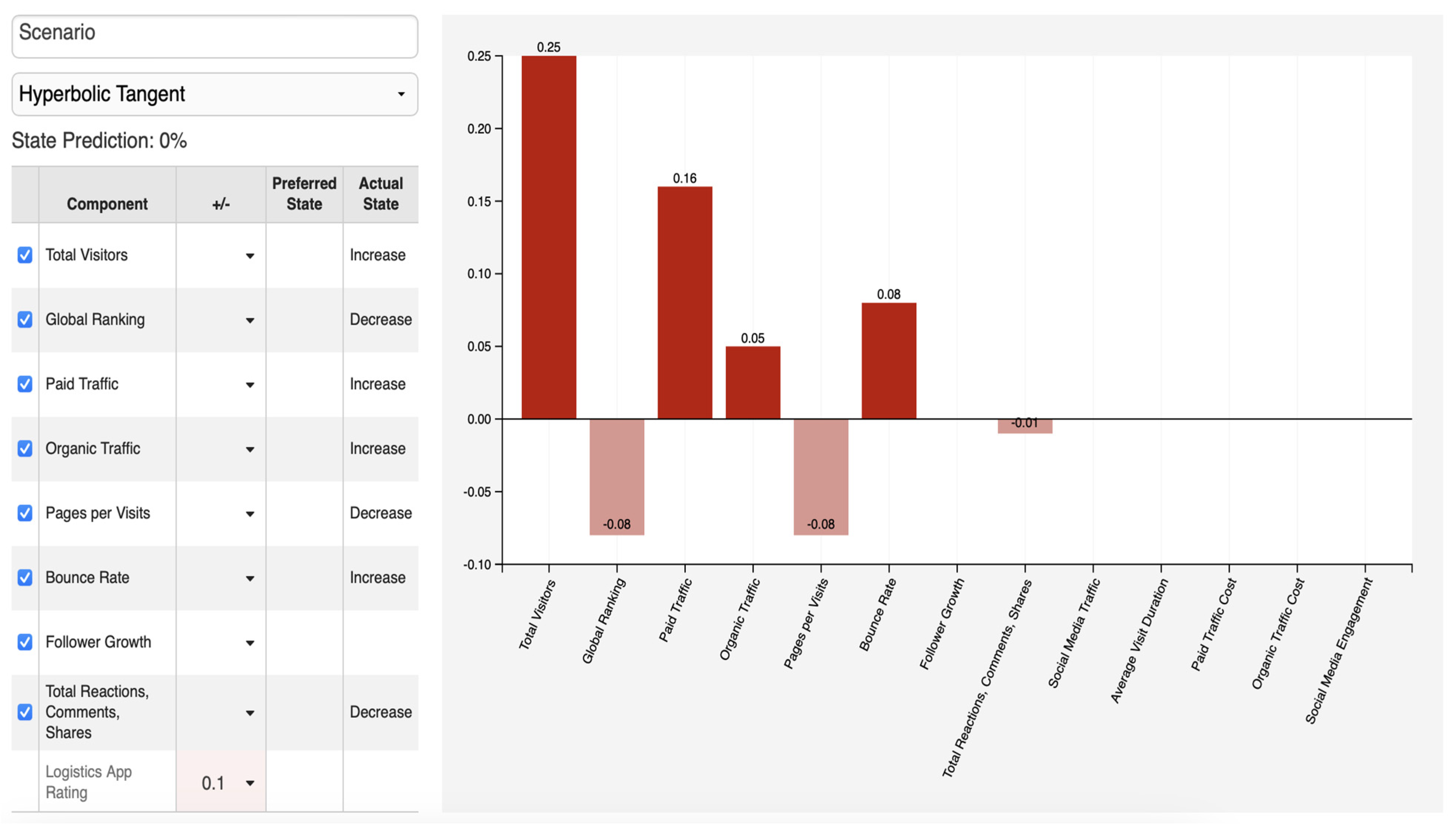
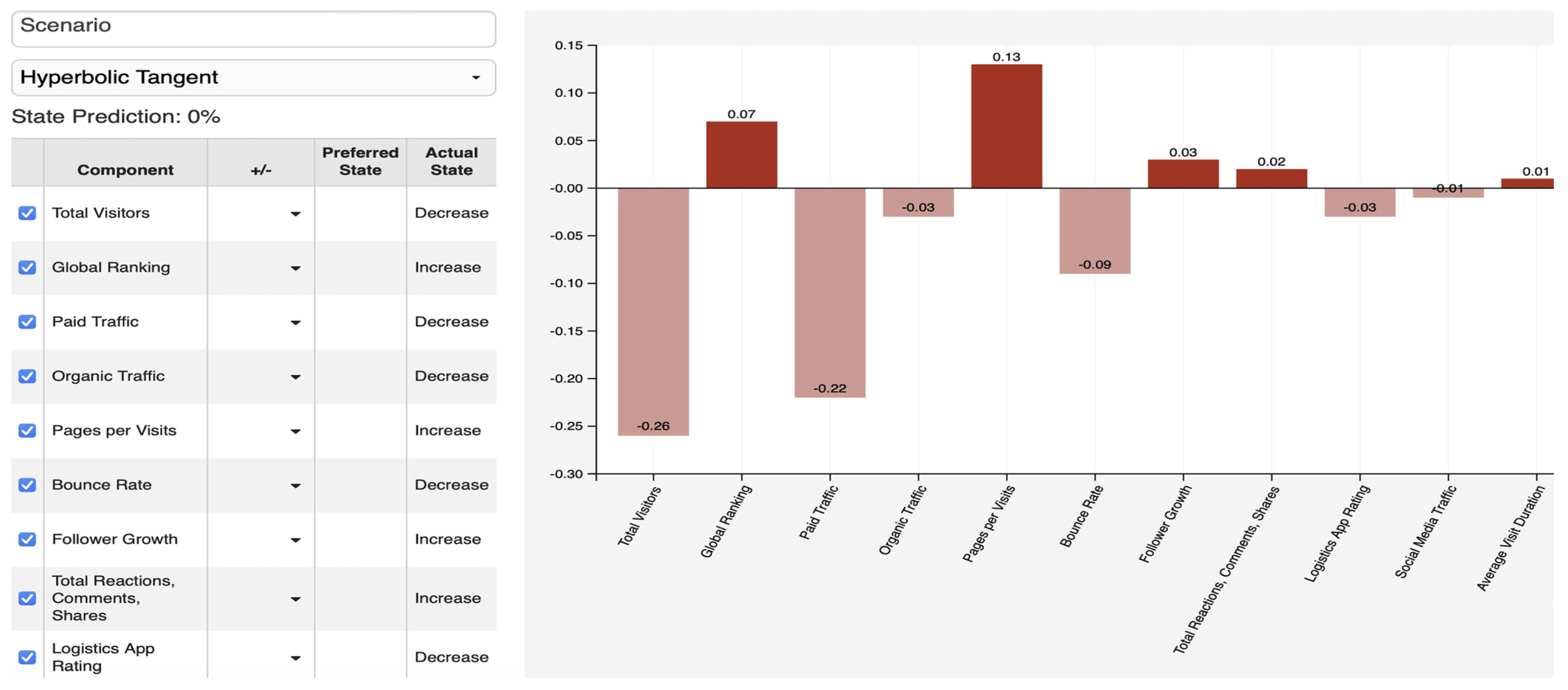
| Web Analytics KPIs | Description of the Web Analytics KPIs |
|---|---|
| Websites’ Organic Traffic | Organic traffic refers to people who come to the corporate site in an unpaid way [24,99]. |
| Websites’ Social Media Traffic | Via links or adverts, social media networks such as Twitter redirect consumers to the corporate website [99]. |
| Websites’ Paid Traffic | It refers to a web analytic that is calculated using paid procedures. When consumers click on ads in Google or other websites, customers are redirected to the logistics websites [99]. |
| Websites’ Total Visitors | This web analytic monitors the number of users daily that visit a logistic website [99]. |
| Websites’ Global Rank | Websites’ global rank is calculated based on the overall platform traffic, which takes into consideration the organic traffic, the social media traffic, and the total paid traffic; the smaller the global rank, the more famous the website. For example, a website in 7th place is more famous and visible than a website in the 117th place [24,99]. |
| Websites’ Bounce Rate | This web analytic calculates how many visitors exit the logistic website without taking further action [99]. |
| Websites’ Average Time on Site | This web analytic tracks how much time a user remains on a logistics website [99]. |
| Websites’ Pages per Visit | The number of pages that a user browses in a logistics website [99]. |
| Organic Traffic Cost | This web analytic calculates the cost to place organic keywords by using Google advertisements [99]. |
| Paid Traffic Cost | This web analytic calculates the cost to place corporate advertisements in social media, search engines, and mobile applications [99]. |
| Follower Growth | Follower growth measures the number of new followers on the corporate social media account per week [100]. |
| Total Reactions, Comments, and Shares | This social media analytic indicates the number of interactions on posts that were published at a specific time [100]. |
| Total Social Media Engagement | This web analytic shows an average amount of how much a fan interacts with the posts of a brand [100]. |
| Logistics App Rating | App rating is a score given to a mobile app based on user comments and reviews in order to represent its overall quality, based on the users’ experience. The rating scale is 1 to 5 stars, with 5 being the highest rating [101,102]. |
| Correlations | Social Media Traffic | Logistics App Rating | Total Reactions, Comments, Shares | Follower Growth |
|---|---|---|---|---|
| Social Media Traffic | 1 | |||
| Logistics App Rating | 0.300 * | 1 | ||
| Total Reactions, Comments, Shares | −0.325 * | −0.058 | 1 | |
| Follower Growth | −0.301 * | 0.004 | 0.718 * | 1 |
| Variables | Standardized Coefficient | R2 | F | p Value |
|---|---|---|---|---|
| Constant (Social Media Traffic) | − | 0.177 | 2.870 | 0.048 |
| Logistics App Rating | 0.274 | 0.068 | ||
| Total Reactions, Comments, Shares | −0.182 | 0.425 | ||
| Follower Growth | −0.134 | 0.553 |
| Correlations | Bounce Rate | Pages per Visits | Follower Growth |
|---|---|---|---|
| Bounce Rate | 1 | ||
| Pages per Visits | −0.886 ** | 1 | |
| Follower Growth | −0.321 * | 0.269 | 1 |
| Variables | Standardized Coefficient | R2 | F | p Value |
|---|---|---|---|---|
| Constant (Bounce Rate) | − | 0.792 | 87,411 | 0.000 |
| Pages per Visits Follower Growth | −0.089 −0.862 | 0.000 0.207 |
| Correlations | Paid Traffic | Follower Growth | Organic Traffic | Social Media Traffic |
|---|---|---|---|---|
| Paid Traffic | 1 | |||
| Follower Growth | −0.338 * | 1 | ||
| Organic Traffic | 0.786 ** | −0.226 | 1 | |
| Social Media Traffic | 0.937 ** | −0.301 * | 0.939 ** | 1 |
| Variables | Standardized Coefficient | R2 | F | p Value |
|---|---|---|---|---|
| Constant (Paid Traffic) | − | 0.952 | 300,341 | 0.000 |
| Follower Growth Organic Traffic | −0.011 −0.794 | 0.748 0.000 | ||
| Social Media Traffic | 1.679 | 0.000 |
| Correlations | Global Ranking | Total Visitors | Logistics Apps Rating | Social Media Traffic | Average Visit Durations |
|---|---|---|---|---|---|
| Global Ranking | 1 | ||||
| Total Visitors | −0.569 ** | 1 | |||
| Logistics Apps Rating | 0.088 | −0.123 | 1 | ||
| Social Media Traffic | −0.345 * | 0.931 ** | −0.009 | 1 | |
| Average Visit Duration | −521 ** | 0.994 ** | −0.064 | 0.928 ** | 1 |
| Variables | Standardized Coefficient | R2 | F | p Value |
|---|---|---|---|---|
| Constant (Global Ranking) | − | 0.724 | 28.909 | 0.000 |
| Total Visitors | −5.232 | 0.000 | ||
| Logistics Apps Rating | 0.001 | 0.993 | ||
| Social Media Traffic | −1.338 | 0.000 | ||
| Average Visit Duration | −3.437 | 0.000 |
| Correlations | Paid Traffic Cost | Organic Traffic Cost | Social Media Traffic | Social Media Engagement |
|---|---|---|---|---|
| Paid Traffic Cost | 1 | |||
| Organic Traffic Cost | 0.908 ** | 1 | ||
| Social Media Traffic | 0.177 | 0.080 | 1 | |
| Social Media Engagement | −0.040 | −0.024 | −0.135 | 1 |
| Variables | Standardized Coefficient | R2 | F | p Value |
|---|---|---|---|---|
| Constant (Paid Traffic Cost) | − | 0.713 | 31.504 | 0.000 |
| Organic Traffic Cost | 0.839 | 0.000 | ||
| Social Media Traffic | 0.049 | 0.000 | ||
| Social Media Engagement | −007 | 0.933 |
Disclaimer/Publisher’s Note: The statements, opinions and data contained in all publications are solely those of the individual author(s) and contributor(s) and not of MDPI and/or the editor(s). MDPI and/or the editor(s) disclaim responsibility for any injury to people or property resulting from any ideas, methods, instructions or products referred to in the content. |
© 2023 by the authors. Licensee MDPI, Basel, Switzerland. This article is an open access article distributed under the terms and conditions of the Creative Commons Attribution (CC BY) license (https://creativecommons.org/licenses/by/4.0/).
Share and Cite
Sakas, D.P.; Reklitis, D.P.; Terzi, M.C. Leading Logistics Firms’ Re-Engineering through the Optimization of the Customer’s Social Media and Website Activity. Electronics 2023, 12, 2443. https://doi.org/10.3390/electronics12112443
Sakas DP, Reklitis DP, Terzi MC. Leading Logistics Firms’ Re-Engineering through the Optimization of the Customer’s Social Media and Website Activity. Electronics. 2023; 12(11):2443. https://doi.org/10.3390/electronics12112443
Chicago/Turabian StyleSakas, Damianos P., Dimitrios P. Reklitis, and Marina C. Terzi. 2023. "Leading Logistics Firms’ Re-Engineering through the Optimization of the Customer’s Social Media and Website Activity" Electronics 12, no. 11: 2443. https://doi.org/10.3390/electronics12112443
APA StyleSakas, D. P., Reklitis, D. P., & Terzi, M. C. (2023). Leading Logistics Firms’ Re-Engineering through the Optimization of the Customer’s Social Media and Website Activity. Electronics, 12(11), 2443. https://doi.org/10.3390/electronics12112443







